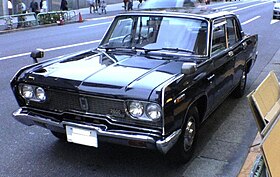Mitsubishi Debonair
| Mitsubishi Debonair | |
|---|---|

1976–1986 Mitsubishi Debonair Executive SE
|
|
| Overview | |
| Manufacturer | Mitsubishi Motors |
| Production | 1964–1998 |
| Assembly | Nagoya Plant, Okazaki, Aichi Japan |
| Body and chassis | |
| Body style | 4-door sedan |
| Chronology | |
| Successor | Mitsubishi Proudia |
| First generation (A30-A33) | |
|---|---|

A31 Debonair (1970–1973)
|
|
| Overview | |
| Production | 1964–1986 |
| Designer | Hans Bretzner (1964) |
| Layout | FR layout |
| Powertrain | |
| Engine | |
| Dimensions | |
| Wheelbase | 2,690 mm (106 in) |
| Length | 4,670 mm (184 in) |
| Width | 1,690 mm (67 in) |
| Height | 1,465 mm (57.7 in) |
| Curb weight | 1,330 kg (2,930 lb) |
| Second generation (S10) | |
|---|---|

Mitsubishi Debonair "V" 2.0 V6 "Super Saloon" (supercharger)
|
|
| Overview | |
| Also called | Hyundai Grandeur |
| Production | 1986–1992 |
| Layout | FF layout |
| Powertrain | |
| Engine | 2.0 L 6G71 V6 SOHC 3.0 L 6G72 V6 SOHC 3.0 L 6G72 V6 DOHC |
| Transmission | 4-speed automatic |
| Dimensions | |
| Wheelbase | 2,735 mm (107.7 in) 2,885 mm (113.6 in) (Royal 150) |
| Length | 4,690 mm (185 in) (2.0 V6) 4,865 mm (191.5 in) (3.0 V6) 5,015 mm (197.4 in) (Royal 150) |
| Width | 1,695 mm (66.7 in) (2.0 V6) 1,725 mm (67.9 in) (3.0 V6) |
| Height | 1,425 mm (56.1 in) (2.0 V6) 1,460 mm (57 in) (3.0 V6) |
| Curb weight | 1,400 kg (3,100 lb) (2.0 V6) 1,620 kg (3,570 lb) (3.0 V6) |
| Third generation (S20) | |
|---|---|

Mitsubishi Debonair Exceed Contega
|
|
| Overview | |
| Also called | Hyundai Grandeur |
| Production | 1992–1998 |
| Layout | FF layout |
| Powertrain | |
| Engine | 2.5 L 6G73 V6 3.0 L 6G72 V6 LPG fuel 3.5 L 6G74 V6 |
| Transmission | INVECS 5-speed |
| Dimensions | |
| Wheelbase | 2,745 mm (108.1 in) |
| Length | 4,980 mm (196 in) 5,125 mm (201.8 in) |
| Width | 1,810 mm (71 in) |
| Height | 1,445 mm (56.9 in) |
| Curb weight | 1,590 kg (3,510 lb) 1,840 kg (4,060 lb) |
The Mitsubishi Debonair (Japanese 三菱・デボネア) is a four-door luxury car, introduced by Mitsubishi Motors in 1964 to serve as their flagship passenger vehicle in the Japanese domestic market. The word "debonair" means "gentle, courteous, suave, lighthearted, nonchalant"
The Mitsubishi Debonair was first introduced at the 10th All Japan Motor Show (later renamed the Tokyo Motor Show) October 1963. Its appearance at the time was described as "dignified" and was one of the first Japanese-built sedans with a luxury intent, using a 2.0 L six cylinder and its exterior dimensions were just under Japanese government regulations for vehicles classified as "compact" while offering a spacious interior and luxury refinements of the period.
At its introduction, it was regarded as a luxury Mitsubishi Colt 1000, as the Mitsubishi Galant had not been introduced until 1969, and was the largest sedan Mitsubishi had built to date. In Japan, it was sold at a specific retail chain called Galant Shop starting in 1969 with the introduction of the Mitsubishi Galant. At the time of the Debonair's introduction, Mitsubishi had a market reputation of building small, economical sedans, letting other manufacturers build larger, more expensive sedans. The Debonair was seen as a special purpose vehicle, and not marketed towards the general motoring public. Production began in time for the 1964 Summer Olympics held in Tokyo in October 1964. Mitsubishi had earlier used this approach to building an exclusive vehicle for senior members of Mitsubishi executives with the first vehicle built by Mitsubishi, called the Mitsubishi Model A.
Three distinct generations were available during its 35-year production run until it was replaced in 1999 with the Mitsubishi Proudia in an attempt to continue to offer a top level luxury sedan. The first and second generation models were used by senior level executives of the Mitsubishi Group and affiliated companies, or essentially a Mitsubishi senior executive company car made by the motor vehicle division of Mitsubishi.
...
Wikipedia
